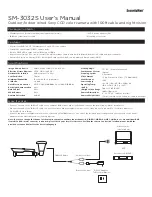
6
Fig. 7:
Pole Mount
Wiring the Transmitter
– Pole Mount
(NOTE – Pole mounting bracket included.)
1. Remove the cover. Remove the screw under
the lens unit in order to detach the mounting
plate. See fig. 4.
2. Break a hole in the mounting plate’s rubber
grommet, and pull the cable through the
grommet’s hole. Then run the cable through
the hole near the bottom of the sensor unit so
it comes out the front. Use the included
mounting bracket to mount to the pole. Then
reattach the sensor unit to the mounting plate,
connect the wires, and snap on the cover.
See fig. 7.
Wiring (fig. 8)
1. Screw the wires tightly to avoid slipping off the
terminals, but not so tight that they break.
2. Screws on terminals which are not used
should be tightened.
3. Grounding may be necessary, depending on
the location.
Wiring the Transmitter – Wall Mount
1. Remove the cover. Remove the screw under the
lens unit in order to detach the mounting plate.
See fig. 4.
2. If the sensor wiring comes from inside the wall –
Break a hole in the mounting plate’s rubber
grommet, and pull the cable through the
grommet’s hole. Then run the cable through the
hole near the bottom of the sensor unit so it
comes out the front. Using two of the included
mounting screws, attach the mounting plate to
the wall. Then reattach the sensor unit to the
mounting plate, connect the wires, and snap on
the cover. See fig. 5.
3. If the sensor wiring is run along the surface of the
wall – There are four plastic knockouts on the
back of the sensor unit, two on top and two on
bottom. Break out the appropriate knockout, and
pull the wiring through the knockout. Then run the
wiring through the hole near the bottom of the
sensor unit so it comes out the front. Using two of
the included mounting screws, attach the
mounting plate to the wall. Then reattach the
sensor unit to the mounting plate, connect the
wires, and snap on the cover. See fig. 6.
Fig. 5:
Wall Mount,
Wire from
Inside Wall
Fig. 6:
Wall Mount,
Wire Runs
Along Wall
– or –
Fig. 4:
Remove the
Transmitter
cover
SECO-LARM
®
U.S.A.
ENFORCER Quad-Photobeam Detectors





























